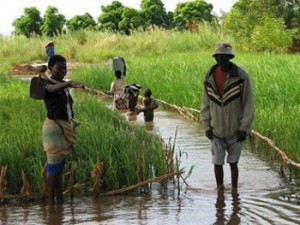 1.1 The Malawi smallholder farmer maize economy
1.1 The Malawi smallholder farmer maize economyMalawi is a landlocked country in the southern Africa with about 13.1 million people. Its economy is heavily dependent on agriculture, which employs 78 per cent of the national labour force (Republic of Malawi, 2009). Maize is grown by 97 per cent of the farmers mostly (if not all) grown without irrigation in the single annual rainy season (October to April) and accounts for 60 per cent of total calorie consumption. This therefore, means that maize is at the centre of Malawi’s economy both as a major economic activity for the majority of the Malawians as well as for national food security.
As a cereal crop, maize’s productivity and production in Malawi have over time varied directly with the national fertilizer availability and use in the maize crop production. This was recognize very early in Malawi’s agriculture history and soon after independence the Malawi Government established a smallholder farmer support system mostly targeting the maize sub-sector. The support package included:
1. Establishment and support to the national agricultural research stations for breeding new maize varieties,
2. Establishment and support to the national agricultural extension services to farmers,
3. Provision of subsidies on agricultural credit and imported farm inputs such as fertilizers, pesticides and seeds,
4. Establishment and maintenance of smallholder irrigation facilities for food production,
5. Creation and management of Agricultural Development and Marketing Corporation (ADMARC), as an official state agricultural marketing board for small farmers’ inputs and outputs,
6. Establishment and management of the national strategic grain reserves to act as national buffer stocks and also for consumer price control,
As with most SSA countries, Malawi adopted the structural adjustment programme. In 1990, the World Bank pushed the Government of Malawi to eliminate fertilizer subsidies entirely with the theoretical premise that national food security could better be achieved by farmers shifting to growing cash crops for export and then using the export earnings to import food. The subsidies were eliminated in phases and were completely abolished in 1995. This essentially meant that the imported chemical fertilizer has to be purchased at full commercial market price. With subsequent reforms in the financial sector, chiefly, the floatation and massive devaluation of the local currency (Malawi Kwacha) against the US Dollar and other major international currencies, the local market price of the imported fertilizers tripled between 1997 and 1998. As a result a majority of the smallholder farmers could not afford, access and use the fertilizers in their maize crop production. The period between the official complete abolishment of fertilizer subsidies (that is 1995), and official re-introduction of fertilizer subsidies (that is, 2006), was characterized by absence of significant fertilizer use, depleted soil nutrients particularly, Nitrogen (Sanches, 2002; Republic of Malawi, 2006), low national average maize yield of 1.3 tons per hectare, negative national maize food grain balance sheets with over half of the national farming households operating below subsistence (Republic of Malawi, 2006). The national food supply security was characterised by recurrent nation-wide food deficits and appeals for food aid. The same period saw an influx of non-governmental organizations (NGOs) setting up and implementing a multitude of different relief interventions in different parts of the country often as reactive responses to annual food deficits and hunger. These efforts, however, only managed to make the food poverty “warm”.
In part response to the endemic food crises, the government of Malawi in 1998/1999 crop season introduced the universal Starter Pack Scheme (SPS) to improve food production. Under this scheme, 2.8 million smallholder farmers were given free packages
[1] of seeds and fertilizers just enough for 0.1 hectare of farmland per farming household. This resulted in national surplus of 420, 000 tons of maize. The SPS programme was repeated in the 1999/2000 crop season and yielded a surplus of 280, 000 tons of maize grain. The SPS programme was, however, modified starting with the 2000/2001 crop season by a condition of targeting specific poor farmers and it was renamed Targeted Input Programme (TIP). Consequently, in the seasons between 2000/2001 to 2004/05 the number of smallholder farmers participating in the TIP reduced and ranged between one and two million. Unlike the SPS, the TIP produced no surpluses and instead, Malawi experienced some deficits in maize food. Part of the explanation could be that the reduced number of beneficiaries effectively reduced the quantity of fertilizers used in maize production, hence low yields and output. The severity of hunger grew with better and more stringent TIP Programme targeting and it reached its climax in 2005 when the Malawi Vulnerability Assessment Committee (MVAC) estimated that up to 38 per cent of the Malawi population required food aid. In this year, national maize yield averaged 0.76 ton per hectare, 40 per cent below long term average, and maize production was only 57 per cent of the national requirement. To fill the gap, the government of Malawi with assistance from its cooperating partners imported maize grain to the cost of US$110 million. Including the cost of TIP Programme and massive NGO activity, the total donor aid to Malawi in the same year (2005) was US$578 million (Malawi Governmet, 2006).
1.2 The Malawi Farm Input Subsidy (FIS) Programme
Despite adverse reactions and objections from some of its key cooperating partners, the Government of Malawi adopted a policy reversal to the old Farm Input Subsidy (FIS) Programme starting 2005/06 cropping season. In this programme Government distributed 3.4 million coupons to poor smallholder farmers that enabled the participating farmer pay only MK2,050 (US$16.40) for the market price of MK5,500 (US$44.00) per 50kg bag of fertilizer representing a 63 per cent subsidy. A total of 320, 000 tons fertilizer and 6,000 tons of improved seed were distributed to a total cost of MK7.2 billion (US$58 million) representing direct cost of purchasing and distribution. With this level of investment, national average maize yield increased more than double from 0.76 ton per hectare to 1.59 ton per hectare from 2004/2005 to 2005/2006 crop seasons, respectively. The same increase was reported for national maize production from 1.23 million tons to 2.58 million tons, translating into 510,000 tons of maize national surplus. In the subsequent season (2006/2007), the number of fertilizer subsidy coupons were increased from 3.4 million to 3.5 million and in addition two million maize seed coupons (each for 2kg of hybrid seed or 3kg OPV seed) were also distributed. This investment resulted in maize yield increase from a national average of 1.59 ton per hectare in 2005/2006 crop season to 2.04 ton per hectare in the 2006/2007 crop season. This push total maize production from 2.58 million tons to 3.44 million tons in the same period. In this year, Malawi exported over 300,000 tons of surplus maize to neighbouring countries including Zimbabwe, generating foreign currency revenue to the tune of US$120 million against the total programme cost for the 2006/2007 season of US$72 million (Dorward et al., 2008). Apart from earning foreign exchange revenue, export of surplus maize enabled Malawi to contribute to the regional food security.
1.3 Is Farm Input Subsidy Enough?
Definitely not! The Malawi FIS Programme is vulnerable to many external risks and still has internal challenges. Main external threats are two: rainfall dependency and fertilizer import dependency. The first one is the fact that since almost 100 percent of Malawi maize production is rain-fed, any serious drought potentially undercuts the investment in, and anticipated gains from the FIS Programme. Secondly, any rapid rises in the landed cost of fertilizers in Malawi (a landlocked country) may entail a big budget shortfall that may lead to downscaling the number of participants or level of subsidy per FIS participant. Internally, Doward et al. (2010) noted in the evaluation report of the 2009/2010 FIS Programme that the Programme seems not to have clear criteria for determining the number of, and for selecting, the programme participants. This in part creates uncertainity on the part of beneficiaries as they will not know with certainty whether they will be eligible or not to receive the subsidy coupons. This has led to a lot of chaos during the distribution of coupons and purchase of fertilizers with so many people arrested each year including senior government officers and local leaders. Again, while at macro-level, much gain has been registered, at micro-level, not all the programme participants benefit despite receiving the FIS coupon due to the fact that they poorest of the poor (who are the official target group-the elderly, orphaned children, disabled) often lack labour a critical complementary maize production input.
1.4 What next?
Removal of subsidy will be a political suicide of any Malawian leader who attempts to do so. The best way forward is to continue improving on the design. Cognizant of the above challenges, there is therefore, need to devise a model for determining a) the economically appropriate rate of subsidy per FIS participant and length of stay in the FIS Programme, b) targeting farmers with potential to succeed in the FIS, and c) incentive package for motivating graduation of successful farmers out of FIS Programme.
Due to its political momentum, the FIS Programme has reduced both the policy and energy of Ministry of Agriculture to FOOD SECURITY, specifically, MAIZE. Of course it is justifiable considering that 97 percent of the farmers are engaged in maize production. However, Ministry of Agriculture has a broader role than just food security. The tobacco, sugar, tea, cotton, rice, ground nuts, livestock, fisheries, horticulture development equally need a strategy for support. Otherwise, the maize bias will risk turning the country into a maize economy while losing on the potential national and regional markets for the other commodities.
Ultimately, Malawi should aim at creating commodity geographical zones based on agro-ecological potential and develop comprehensive development plans including human resource, equipment, capital, markets, and related infrastructure, policies and institutions.
Proper assessment and surveillance of the internal, regional and international market will be a key pre-liquisite input into the Comprehensive Plan.
Key to this Comprehensive Plan will be nurturing development and growth of small, medium and large entreprenuers in the commodity value chain with financing terms that accommodate for entrepreneurial learning and long-term private investments in irrigation.
The government will have to invest in few but clearly identified and beneficial research while exploiting research opportunities availed by the CGIARs and other regional commodty-specific research orgaizations. The identification of government funded research priorities should closely engage commodity value chain actors through their institutions.
Work with the Regional Economic Integration Community (COMESA, SADC) towards a unified regional agricultural policy while aligning both national and regional agricultural policy to the African Union’s Framewok of CAADP. In addition to creating trade space for regional commodties, the unified policy will also be important in strengthening leverage of the bloc in the WTO and other extra-regional trade negotiations including climate change.
[1] The SPS and TIP package comprised 10kg NPK fertilizer, 5kg Urea with 2kg hybrid maize seed or 8kg rice seed, plus 1kg each of ground nuts, beans, soya beans, and pigeon peas depending on the part of the country.
 1.1 The Malawi smallholder farmer maize economy
1.1 The Malawi smallholder farmer maize economy
